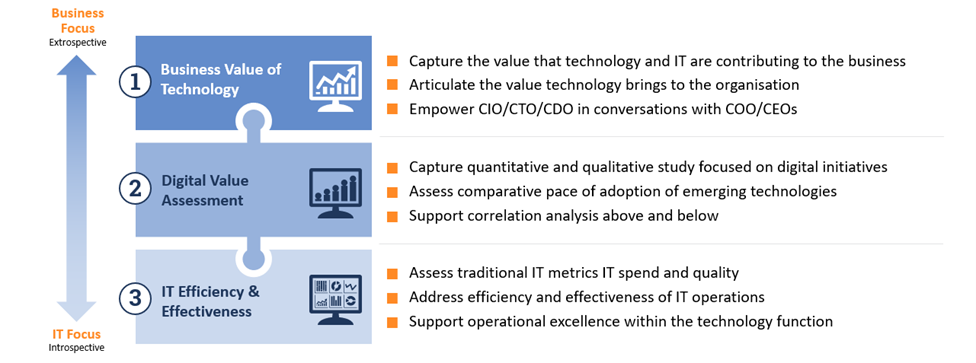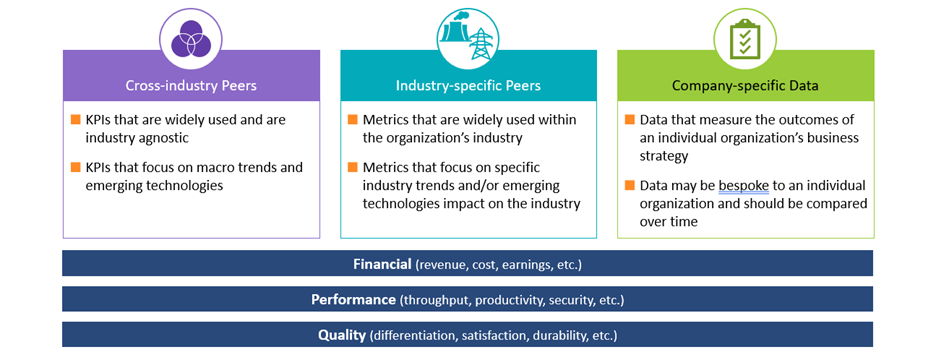The Business Value of Technology
The past few years have witnessed a rapid convergence of business and IT. In fact, many traditional enterprises now view themselves as being in the business of IT. Giants such as Amazon and Uber have upended more than just retail and transportation; all industries are looking at these examples, either to emulate the disruptors or protect themselves from the disruption.
Many organizations are trying to understand how digital technologies like the cloud and blockchain – and approaches like Agile and DevOps – will impact their business, and, more importantly, how they should position their organizations to harness the benefits of the digital era.
Regardless of how IT and business are transforming, one challenge has stayed constant: how to ensure technology enables the business.
CIOs are faced with numerous questions, such as:
- Does the business have the tools in place to sustain performance and maintain resiliency for both its immediate and long-term needs?
- Has IT deployed technologies to enhance the customer experience, help attract and retain customers and, ultimately, contribute to the bottom line?
- Is the organization properly protecting its customer and operational information and assets?
- With an aging workforce and changing skill requirements, is the organization able to attract the talent required?
- Is the organization positioned to support divestures and acquisitions?
- How can technology enable the organization to reduce emissions and facilitate adoption of alternative energy sources?
- Is the organization leveraging its data assets to continuously improve operations?
For the past ten years, IT has been largely introspective, measuring cost, productivity and stability. When it comes to answering the questions that get at the business value of technology, the conversation must now pivot to center on the experiences of the customers and the business outcomes generated by technology.
ISG’s Modular Approach to Measuring and Communicating the Business Value of Technology
Traditional measurements are not going away, nor do we advocate for their removal from the standard performance reporting. Measuring IT efficiency and effectiveness goes a long way in addressing and supporting operational excellence within the technology function. However, to truly transform a technology organization from being a supplier to the business to a partner and driver of the business, IT needs to supplement its approach to measuring and communicating value.
In conversations with business leaders, effective CIOs must recognize and acknowledge where IT is excelling and where it needs to add focus. In these contexts, digital value assessments can provide quantitative and qualitative measures focused on digital initiatives; they help compare the pace of adoption of emerging technologies to that of peer organizations.
To ensure continuous improvement and evolve at the pace of business change, technology organizations need to begin to capture the business value of technology and IT. These measures should be used to articulate technology value and empower CIOs, CTOs and CDOs in conversations with business leaders.

Figure 1: ISG’s Modular Approach to Measuring and Articulating the Business Value of Technology
ISG’s Business Value of Technology Measurement Framework
The ISG framework for measuring the business value of technology is aligned along five key pillars, with progressive levels of measurement within an organization.
- Revenue contribution: understanding technology’s contribution to business innovation, data insights and monetization, revenue and value realization
- Cost optimization: measuring technology’s contribution to reducing or avoiding business operational expenses
- Delivery excellence: assessing technology’s impact on protecting business value (security), enabling the workforce and improving service quality and reliability
- Customer experience: capturing the impact of technology on brand strength, campaign ROI and both user and customer satisfaction
- Environmental, social and governance (ESG): evaluating the impact of technology on ESG initiatives, including diversity and inclusion, environmental performance, carbon reduction and the adoption of alternative energy.
As organizations embark on changing how they measure IT, we recommend taking a walk-crawl-run approach. It is important to achieve early success by building measures at the enterprise level and leveraging available data to support actionable insights aligned with the business strategy.
Then, as the organization matures its approach, measurements captured at the business function – or even the business sub-function level – will provide meaningful and actionable insights that can help organizations achieve their business goals.

Figure 2: The Business Value of Technology Measurement Framework
Leveraging Market Intelligence to Compare and Learn from World-class Firms
By defining a business value of technology measurement framework, organizations can evaluate performance through comparison with external data to compare and learn from industry leaders. ISG’s Benchmarking practice advocates comparing against three different domains, depending on the KPI being measured.
Cross-industry peers – there are many widely adopted KPIs that are industry agnostic and that focus on macro-trends and emerging technologies. Organizations should look to measure themselves against best-in-class performance regardless of industry, particularly in areas such as cost efficiency of commodity and non-differentiating IT services.
Industry-specific peers – industry-specific KPIs focus on metrics that are differentiated according to operating model and business value chain. For example, IT’s contribution to business output will differ by vertical (e.g., claims processed, assets under management, barrels of oil sold, units manufactured). For these examples, we recommend comparing value against peers in related industries.
Company-specific data – Some metrics may be defined to measure performance relative to unique organizational objectives. In this circumstance, the basis of comparison should be against historical levels of performance or intra-company comparison, (e.g., region one vs. region two).
To provide a holistic view of performance, ISG’s framework encourages measurement across three inter-related dimensions; financial, operational performance and quality and satisfaction.

Figure 3: Leveraging Market Intelligence to Compare and Learn from World-class Firms
Key Principles in Defining the Business Value of Technology
Success in measuring and communicating the business value of technology depends on an organization’s commitment. To achieve success, organizations should align the measurements with four key principles in mind:
- Focus on business outcomes. Not how IT measures IT, but how technology supports our business goals.
- Technology has moved beyond its enabling role to creating tangible business value through differentiating, digital initiatives.
- Technology is increasingly engrained in business processes, leading to continuous outcomes instead of waterfall planning.
- The pace of change is not subsiding, and value can be created through
digital partnerships.
ISG understands the value of IT to the business. We have a proven track record in creating change and a team of experienced professionals who help organizations adopt effective, forward-looking, business-centric performance management dashboards and benchmarks that enable organizations to achieve measurable efficiencies and provide sustainable value. Contact us to discuss how we can help you.
